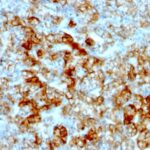Human, Mouse, Rabbit, Canine, and Rat Anti-Ksp-Cadherin / CDH16 Antibody Product Attributes
Ksp-Cadherin / CDH16 Previously Observed Antibody Staining Patterns
Observed Antibody Staining Data By Tissue Type:
Variations in Ksp-Cadherin / CDH16 antibody staining intensity in immunohistochemistry on tissue sections are present across different anatomical locations. An intense signal was observed in cells in the tubules in kidney and glandular cells in the thyroid gland. More moderate antibody staining intensity was present in cells in the tubules in kidney and glandular cells in the thyroid gland. Low, but measureable presence of Ksp-Cadherin / CDH16 could be seen in. We were unable to detect Ksp-Cadherin / CDH16 in other tissues. Disease states, inflammation, and other physiological changes can have a substantial impact on antibody staining patterns. These measurements were all taken in tissues deemed normal or from patients without known disease.
Observed Antibody Staining Data By Tissue Disease Status:
Tissues from cancer patients, for instance, have their own distinct pattern of Ksp-Cadherin / CDH16 expression as measured by anti-Ksp-Cadherin / CDH16 antibody immunohistochemical staining. The average level of expression by tumor is summarized in the table below. The variability row represents patient to patient variability in IHC staining.
| Sample Type | breast cancer | carcinoid | cervical cancer | colorectal cancer | endometrial cancer | glioma | head and neck cancer | liver cancer | lung cancer | lymphoma | melanoma | ovarian cancer | pancreatic cancer | prostate cancer | renal cancer | skin cancer | stomach cancer | testicular cancer | thyroid cancer | urothelial cancer |
|---|---|---|---|---|---|---|---|---|---|---|---|---|---|---|---|---|---|---|---|---|
| Signal Intensity | – | – | – | – | – | – | – | – | – | – | – | – | – | – | – | – | – | – | – | – |
| CDH16 Variability | + | + | ++ | + | ++ | + | + | + | + | + | + | + | + | + | ++ | + | + | + | + | + |
| Ksp-Cadherin / CDH16 General Information | |
|---|---|
| Alternate Names | |
| Cadherin-16, CDH16 | |
| Molecular Weight | |
| 130kDa | |
| Chromosomal Location | |
| 16q22.1 | |
| Curated Database and Bioinformatic Data | |
| Gene Symbol | CDH16 |
| Entrez Gene ID | 1014 |
| Ensemble Gene ID | ENSG00000166589 |
| RefSeq Protein Accession(s) | NP_001191673, XP_005255827, NP_001191675, NP_004053, XP_011521109, NP_001191674 |
| RefSeq mRNA Accession(s) | NM_001204746, NM_004062, NM_001204745, XM_005255770, XM_011522807, NM_001204744 |
| RefSeq Genomic Accession(s) | NC_018927, NC_000016 |
| UniProt ID(s) | O75309 |
| UniGene ID(s) | O75309 |
| HGNC ID(s) | 1755 |
| Cosmic ID(s) | CDH16 |
| KEGG Gene ID(s) | hsa:1014 |
| PharmGKB ID(s) | PA26289 |
| General Description of Ksp-Cadherin / CDH16. | |
| This MAb recognizes a protein of 130kDa, identified as Ksp-cadherin. Cadherins form a superfamily of related glycoproteins that mediate calcium-dependent cell adhesion, transmit signals from the extracellular matrix to the cytoplasm. Cadherins have been implicated in embryogenesis, tissue morphogenesis, tissue structure maintenance, cell polarization, neoplastic invasiveness, metastasis,, membrane transport. It is suggested that Ksp-cadherin is a marker for terminal differentiation of the basolateral membranes of renal tubular epithelial cells. Within the kidney, Ksp-Cadherin is found exclusively in the basolateral membrane of renal tubular epithelial cells, collecting duct cells,, not in glomeruli, renal interstitial cells, or blood vessels.Ksp-Cadherin has been suggested to distinguish Chromophobe Renal-Cell Carcinoma from Oncocytoma. | |




There are no reviews yet.